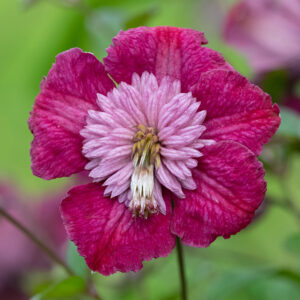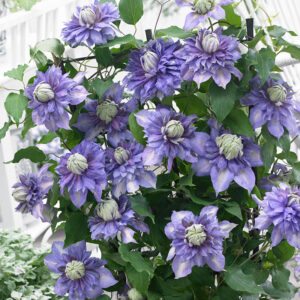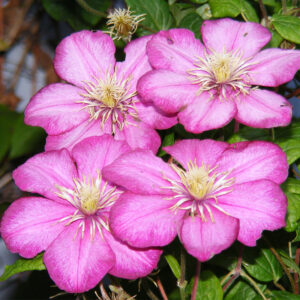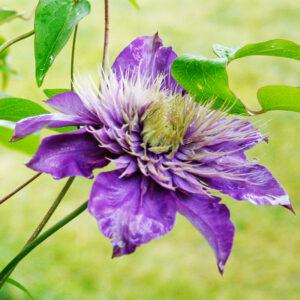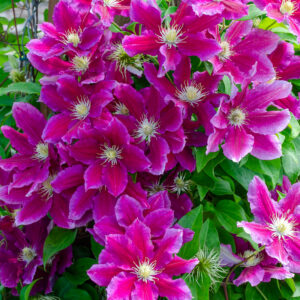With their tendrils and sensational blooms, clematis vines are something from a fairy tale. Clematis blooms vary in color, shape, and size. The flowers are unique and showy, which makes them such a popular climbing vine. Once established clematis will live for many years, however, getting them established can take some work. Our complete guide to growing clematis provides information on successfully growing clematis in your garden.
Complete Guide to Growing Clematis Vines
When is the best time to plant clematis?
Clematis are perennial plants that will return to your garden for several years. The best time to plant clematis vines is in spring or early summer. Planting early in the season allows the roots to establish months before winter. Planting clematis before the soil warms up in mid to late summer will benefit the roots as well. Late season planting like summer or early fall is also possible. However, planting later in the season may require extra care, such as increased watering and protection of the roots.
Where to plant clematis?
Plant clematis in an area that receives full to part sun. The leaves and above-ground growth need the sun to produce blooms and healthy foliage. Therefore, the area should receive 6 hours or more of direct sun a day. Clematis should be planted in moist soil that drains well.
The roots of clematis do not like the heat. Therefore, the roots must be kept cool. To ensure the soil remains cool where your clematis is planted add mulch to the planting area. Other ways to cool the soil are to plant annuals or perennial ground cover at the base of the clematis.
Another consideration when choosing a location for clematis is how exposed they are to the elements. While these plants are fairly tough they prefer a sheltered location that will provide relief from strong, drying, and damaging winds.
What structures will clematis climb on?
Vining plants have different methods of climbing. Some vines will attach to a surface or structure using suction-cup like tendrils. Vines like Boston Ivy are an example of a climbing plant that latches on to surfaces like brick or vinyl siding with suction cup-like tendrils. Clematis climb using tendrils that wrap around surfaces. They don’t have suction cup-like tendrils; therefore they are not used for climbing walls.
Clematis grow best on vertical surfaces they can climb and wrap their tendrils. Chain link fences, trellises, and arbors are the best structures for clematis to climb and grow on.
What zones are best for growing clematis?
Clematis grow best in hardiness zones 3-8. Since there are many different cultivars and varieties of clematis it is best to check each individual type before planting to make sure they will grow in your hardiness zone.
When do clematis vines bloom?
Clematis vines have varying bloom times. Some clematis bloom in late spring into early summer. Others produce an initial surge of blooms in late spring and then continue blooming throughout the summer. Varieties like Sweet Autumn Clematis bloom in late summer into early fall. In general clematis blooms are most prevalent in early summer and mid-summer.
Plants that bloom for long periods of time tend to be the most popular. If you are looking for clematis with a long bloom time, here are some suggestions: Diamantina Clematis, Double Purple Clematis, Fairy Dust Clematis, Multi Blue Double Clematis, Proteus Double Clematis, and Ramona Clematis.
What do clematis flowers look like?
Clematis bloom shapes can vary. Many are star-shaped and can range in size from 1/2″-6″+ in size. Pink, red, purple, and white are the most common shades of clematis flowers. Some blooms have multiple colors in the petals. Clematis blooms can also be double petaled. Bell-shaped flowers are seen on some varieties of clematis as well.
How to prune clematis?
Pruning clematis is important to make sure you have blooms year after year. There are three pruning types of clematis which are based on bloom times.
Clematis in pruning group 1 bloom early in spring. Prune clematis group 1 shortly after they finish blooming in spring. Remove any dead stems and leaves at this time as well.
Group 2 clematis bloom early to mid-season typically in May and June. They tend to have large-showy flowers. Prune group 2 clematis in spring before growth forms. Remove any damaged or dead stems. Trim stems back to where buds are visible.
Group 3 clematis bloom mid-to-late summer. Large and showy flowers are common on group 3 clematis. Cut back group 3 clematis in early spring before growth occurs. When determining where to cut back to, locate the buds that are about 6-8″ from the ground and cut back to that point.
How to plant a bare root clematis?
When ordering a clematis from an online retailer such as Holland Bulb Farms it will arrive as a 2-year bare root plant start. Some top growth will be visible on the plant start. The roots will have soil around them, and a small root ball may have formed.
Bare root clematis should be planted in a small container initially upon receiving. Planting them in a small container will help the roots and top growth establish prior to being planted in the ground. By starting the clematis in a pot first, it will make monitoring the amount of water the clematis receives much easier. After 4-6 weeks of the clematis being in the pot, it should be ready to transplant to the ground.
It is important that the crown of the plant, which is where the top growth will come from is not planted too deep. Locate the crown, by noticing where growth is coming from in comparison to the roots. The crown should be near or slightly above the soil level.
After planting be sure to water the clematis. Add mulch or groundcover to keep the roots cool and moist.
Growing Clematis the Best Flowering Vine
Clematis vines have large showy blooms, grow to a manageable size, and offer a variety of flower shapes and colors. These characteristics help make them the best flowering vine for many gardeners. A sunny location and dedication to pruning each year will help make clematis a loved garden plant for 20 years or more.
While some grow faster than others it is always worth the time to watch these vines climb, bloom, and grow over structures in the garden. Find a place in your yard to add a trellis or arbor and be sure to add a delightful clematis vine to your garden space!


